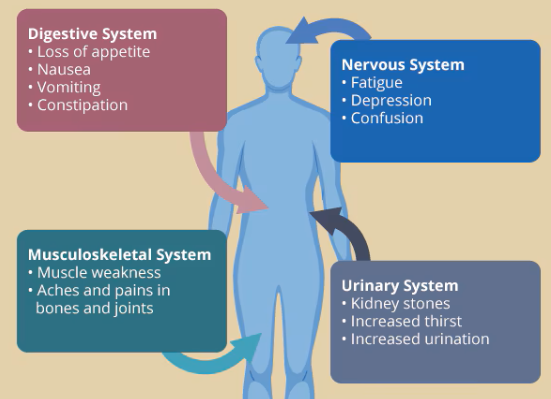How to Lower Calcium Levels: The Definitive Solution for Parathyroid Disease

If you’ve recently been told you have high calcium in your blood, you’re not alone—and you’re probably wondering how to lower calcium levels safely and effectively. While there are many reasons calcium levels may be elevated, the most common cause in adults is a condition called primary hyperparathyroidism, a disease of the parathyroid glands.
Here at the Norman Parathyroid Center, we specialize in treating this condition and helping patients return to a healthy, energized life. In this article, we’ll break down how to lower calcium levels caused by parathyroid disease—and why surgery is the only definitive cure.
How to Lower Calcium Levels: The Definitive Solution for Parathyroid Disease
.png)
What Causes High Calcium Levels in the Blood?
Before we get into how to lower calcium levels, it's important to understand what causes them to rise in the first place. For most adults, especially women over the age of 50, high calcium is usually caused by a parathyroid tumor. This small, benign growth on one of the parathyroid glands causes the gland to overproduce parathyroid hormone (PTH), which then pulls calcium out of the bones and dumps it into the bloodstream.
Over time, this high calcium level can lead to a host of symptoms, including:
- Fatigue
- Memory problems or brain fog
- Bone pain or fractures
- Kidney stones
- Depression or anxiety
- High blood pressure
If you’ve experienced any of these and your labs show high calcium, you need to know how to lower calcium levels—and fast.
Why Medications, Diet, and Supplements Won’t Lower Calcium in Parathyroid Disease
Many patients are told to drink more water, reduce calcium intake, or take medications to manage symptoms. But here’s the truth: if your high calcium is caused by a parathyroid tumor, no amount of diet or medication will fix the problem.
In fact, reducing calcium in your diet can sometimes make things worse, especially for your bones. Your body still needs calcium to function, and if you don’t get it through food, your overactive parathyroid gland will continue pulling it from your bones, leading to osteoporosis and increased fracture risk.
So, when it comes to how to lower calcium levels in the case of parathyroid disease, lifestyle changes won’t work. The only cure is surgery to remove the overactive parathyroid gland.
How to Lower Calcium Levels Permanently: Parathyroid Surgery
The definitive answer to how to lower calcium levels caused by parathyroid disease is simple: remove the diseased gland.
At the Norman Parathyroid Center, we perform a minimally invasive parathyroidectomy—a procedure that typically takes less than 20 minutes and involves a tiny incision. We’ve performed over 40,000 parathyroid operations, more than any other team in the world, and we have a 99% cure rate.
When the overactive gland is removed, your calcium levels drop back to normal, usually within hours. Symptoms start to improve immediately or within a few days, and long-term damage to your bones, kidneys, and brain can be halted or even reversed.
So if you're wondering how to lower calcium levels in a way that truly works, surgery with an expert parathyroid surgeon is the answer.
Why It’s Dangerous to Ignore High Calcium
Some patients are told by their doctor to “watch and wait” or that their calcium levels aren’t high enough to worry about. But even mildly elevated calcium, especially over a long period, can be harmful.
Prolonged high calcium levels can lead to:
- Osteoporosis and increased fracture risk
- Kidney stones and potential kidney damage
- Cognitive decline and memory loss
- Heart and blood vessel problems
- Fatigue and depression that seriously impact quality of life

Waiting does not solve the problem—it simply delays the inevitable and increases the risk of complications. If you're serious about how to lower calcium levels, don’t wait. Get evaluated by a specialist and treat the root cause.
How to Lower Calcium Levels: What Labs You Need
If you suspect parathyroid disease or your labs show elevated calcium, ask your doctor for a PTH (parathyroid hormone) test. This is the key to confirming the diagnosis.
- High calcium + high (or inappropriately normal) PTH = primary hyperparathyroidism
If this is your result, there’s no need for more waiting or additional imaging before speaking to a specialist. You’ve already answered the most important question: why is my calcium high, and how do I lower it?
Where to Get Expert Care for Parathyroid Surgery
If you’re researching how to lower calcium levels, make sure you’re also researching who is performing your surgery. Parathyroid surgery is extremely delicate. The parathyroid glands are tiny—sometimes the size of a grain of rice—and they sit right next to important structures like the vocal cord nerves.
At the Norman Parathyroid Center, our surgeons focus exclusively on parathyroid disease. We operate at the Hospital for Endocrine Surgery in Tampa, Florida, a world-class facility built specifically for endocrine operations. Our entire team—surgeons, nurses, anesthesiologists, and staff—is trained solely in endocrine surgery, meaning you’re in the safest hands possible.
What to Expect After Surgery
After your parathyroid surgery, most patients:
- Go home the same day, usually by lunchtime
- Feel significantly better within days
- Return to normal activities the next day
- See their calcium levels normalize immediately
If you’ve been struggling with symptoms and wondering how to lower calcium levels, the relief you’ve been waiting for could be just one short outpatient surgery away.
The Bottom Line: How to Lower Calcium Levels for Good
To sum it up:
If your calcium is high and your PTH is elevated, you likely have parathyroid disease.
And when it comes to how to lower calcium levels, the only real answer is surgery to remove the diseased gland.
Don’t waste time trying ineffective alternatives. At the Norman Parathyroid Center, we’ve helped tens of thousands of people just like you get cured and get their life back.
Additional Resources:
- Learn more about the Norman Parathyroid Center.
- Read more on the Parathyroid blog.
- Become our patient.
- Check out our sister surgeons at the Clayman Thyroid Center, and the Carling Adrenal Center. We are now united under one roof, operating at the Hospital for Endocrine Surgery.




